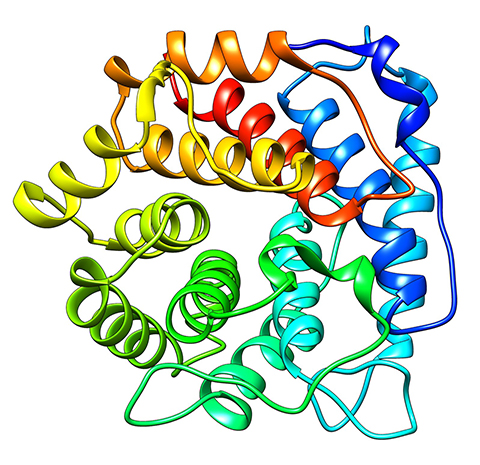From the journals: MCP
A new biomarker for Type 1 diabetes? Seeing beyond the semen to its proteome. A map of mouse proteins. Read about papers on these topics recently published in the journal Molecular & Cellular Proteomics.
A new biomarker for Type 1 diabetes?
Our immune systems play a fascinating and important role in keeping us safe from pathogens that otherwise would wreak havoc on our bodies. For people who have an autoimmune condition such as Type 1 diabetes mellitus, or T1D, a few trigger-happy killer T cells will confuse an otherwise well-running immune system. Since over 60,000 young people develop T1D each year in the U.S. alone, researchers want to better understand the disease’s pathogenesis and find useful clinical biomarkers for its onset.

In a study published in the journal Molecular & Cellular Proteomics, Dinko Šoić from the University of Zagreb, Croatia, and an international team of researchers recently identified a unique sugar biomarker and found that its expression is elevated in children newly diagnosed withT1D compared to their unaffected siblings. The researchers learned that oligomannose glycans elevated in early-onset T1D might be coming from glycoprotein C3, a coordinator of downstream immune response.
The team analyzed plasma C3 levels from 61 newly diagnosed children and 84 of their unaffected siblings using liquid chromatography–mass spectrometry in a cost-effective and high-throughput approach. With a mere 10 microliter sample from each child, the researchers used an affinity capture technique to enrich C3 levels for lysis into a peptide and glycoprotein mixture. After enriching and purifying the glycopeptides, they used the highly sensitive analysis for site-specific profiling of C3 N-glycans.
The researchers reported that these observed changes to the glycosylation profile of plasma may be associated with the onset of T1D and that C3 glycopeptide levels potentially could be used to assess T1D risk. The team has not yet determined whether the changes they observed to N-glycosylation are causing the onset of T1D or are secondary to the pathology; however, C3 N-glycosylation shows promise as a biomarker to help clinicians diagnose and even prevent T1D.
Seeing beyond the semen to its proteome
Across the plant and animal kingdoms, fertilization is an essential aspect of life that is heavily conserved. Researchers know a lot about this process across species as well as in kingdoms, but they still have much to learn about the content and function of the proteins involved.
Martin Garlovsky from the University of Dresden and colleagues from Arizona State University analyzed the sperm proteome of the common fruit fly and identified more than 3,000 proteins using a label-free method of quantitation. With updated technology and bioinformatics, they added greater value to existing data. Using advances in liquid chromatographic systems and data acquisition times, they advanced from simple characterization of the sperm proteome to quantitation, shedding further light on protein function. They described this work in a recent article in the journal Molecular & Cellular Proteomics.
While these proteins largely constituted structural elements such as alpha- and beta-tubulins, the researchers also found seminal fluid proteins and those involved in neuronal function. This could lead to comparison of similarities of the brain and testis, including the shared functional designs of sperm and neurons as high-transmitting information carriers. Also, the prevalence of ribosomal proteins show that sperm may not be as transcriptionally silent as previously thought.
Overall, this research extends knowledge of sperm and seminal fluid protein biology and provides further evidence of the complexity of a seemingly simple system.
A map of mouse proteins
Biomedical researchers frequently use mice in their work because mice have many anatomical, physiological and genetic similarities to humans. Because they are such a valuable model organism, researchers want to find methods to screen and better understand the mouse proteome.
Tian Lu from Fudan University in Shanghai and a team at Westlake University in Hangzhou attempted to provide a more comprehensive map of protein data across different mouse tissues to help researchers better understand protein expression and function in mice. In their recently published paper in the journal Molecular & Cellular Proteomics, they report a comprehensive spectral library of more than 12,000 mouse proteins and a detailed proteomic analysis of 41 mouse tissues.
This analysis better characterizes some rarely studied tissues, including those of the cornea and retina. The team found distinct protein expression in the nervous and immune systems that may lead to greater understanding of transplant rejection in immunocompromised patients in the clinic. They also found greater expression of antioxidant enzymes on the left side of nine paired organs, including the kidneys, testes and adrenal glands. This unprecedented exploration of the mouse proteome may enhance our understanding not only of mice as model organisms but of human disease as well.
Enjoy reading ASBMB Today?
Become a member to receive the print edition four times a year and the digital edition monthly.
Learn moreGet the latest from ASBMB Today
Enter your email address, and we’ll send you a weekly email with recent articles, interviews and more.
Latest in Science
Science highlights or most popular articles

Building the blueprint to block HIV
Wesley Sundquist will present his work on the HIV capsid and revolutionary drug, Lenacapavir, at the ASBMB Annual Meeting, March 7–10, in Maryland.

Gut microbes hijack cancer pathway in high-fat diets
Researchers at the Feinstein Institutes for Medical Research found that a high-fat diet increases ammonia-producing bacteria in the gut microbiome of mice, which in turn disrupts TGF-β signaling and promotes colorectal cancer.

Mapping fentanyl’s cellular footprint
Using a new imaging method, researchers at State University of New York at Buffalo traced fentanyl’s effects inside brain immune cells, revealing how the drug alters lipid droplets, pointing to new paths for addiction diagnostics.

Designing life’s building blocks with AI
Tanja Kortemme, a professor at the University of California, San Francisco, will discuss her research using computational biology to engineer proteins at the 2026 ASBMB Annual Meeting.

Cholesterol as a novel biomarker for Fragile X syndrome
Researchers in Quebec identified lower levels of a brain cholesterol metabolite, 24-hydroxycholesterol, in patients with fragile X syndrome, a finding that could provide a simple blood-based biomarker for understanding and managing the condition.

How lipid metabolism shapes sperm development
Researchers at Hokkaido University identify the enzyme behind a key lipid in sperm development. The findings reveal how seminolipids shape sperm formation and may inform future diagnostics and treatments for male infertility.

